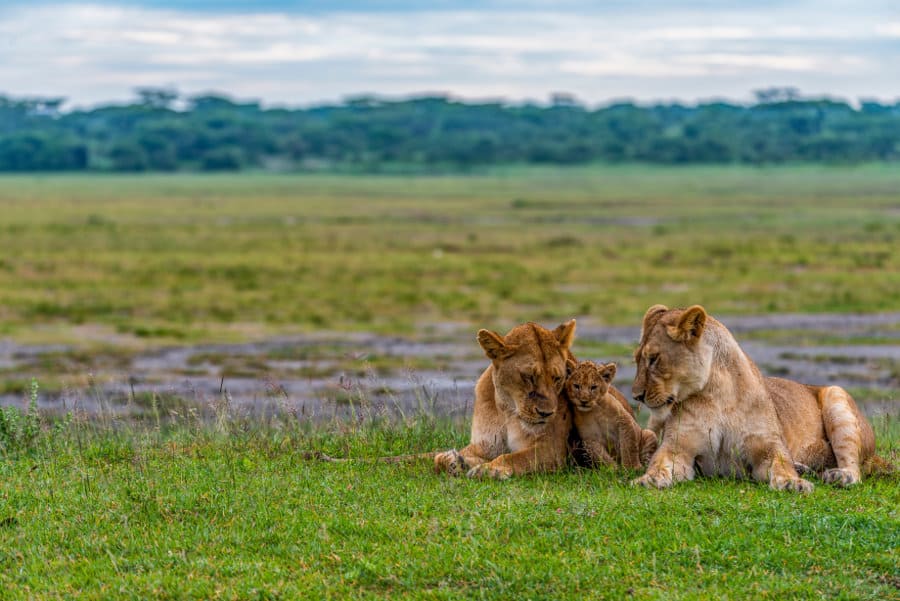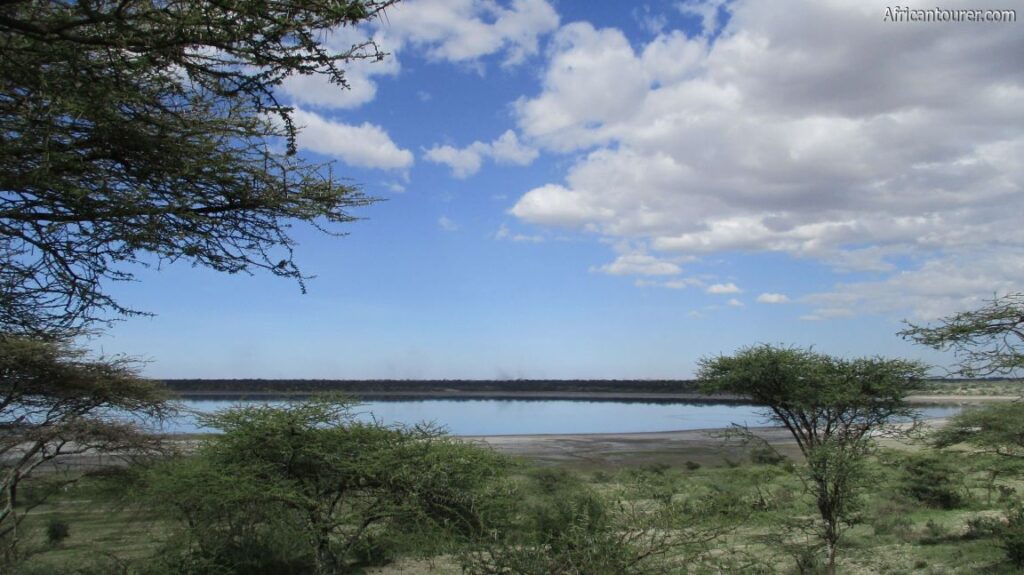Lake Ndutu, Ngorongoro Conservation Area
Lake Ndutu: Comprehensive Information: The saline lake known as Ndutu is located in the center of the southern Serengeti. It transforms into a wonderland with remarkable vistas throughout the verdant season. It is situated adjacent to the acacia woodlands on the Southern Plains. From December to April, the migration ceases here, with only wildebeests and zebras visible as far as the eye can see. The cubs were born during the herd’s resting season at this location. The presence of predators poised to exploit a moment of vulnerability creates a striking yet agonizing spectacle.
Lake Ndutu supplies water to adjacent hotels, campers, and various establishments, as well as to the wildlife. To the east, in the Ngorongoro Conservation Area, it shares the same basin as Lake Masek. The Ndutu cranium and many tool fragments, exceeding 500,000 years in age, were discovered at a 140-square-meter archaeological excavation site undertaken in 1973 near the shores of Lake Ndutu.
Activities and Attractions: Things To Do in Lake Ndutu
Activities and Attractions: Things To Do in Lake Ndutu
Seeing wildlife, as most of the daily activity transpires in the morning when a greater number of animals approach to drink. Thomson’s gazelle, wildebeest (seasonally), zebra, giraffe, and flamingos are among the more prominent species. Additional sites near Lake Ndutu that merit visitation include:
Triangle
This exquisite plain hosts a diverse array of species. This plain transforms into a low grassland during the wet season, attracting numerous herbivorous animals, such as zebras, gazelles, and wildebeests, along with various carnivores including lions, cheetahs, and hyenas. Furthermore, ocelots, storks, and hartebeests migrate here from Europe to evade the severe winter conditions. With fortune, one may witness exhilarating hunting spectacles throughout this period. The location lacks dependable water sources. Consequently, the species capable of inhabiting this area are limited throughout the arid season.

Hidden Valley
Situated roughly 20 kilometers northwest of Ndutu, the Hidden Valley is, as its designation suggests, an obscure site away from the conventional routes. You must deviate from the intended path to arrive at your destination. It is merely a depression in the earth that accumulates water during the rainy season, attracting wildlife.
Predators lie in wait for the opportune moment to pounce, while herbivores approach to drink. Extensive hyena groups may occasionally be observed frolicking in the mud within the basin. This location is highly sensitive from an environmental standpoint, and entry is often restricted. The most likely creatures to be observed include lions, zebras, wildebeests, gazelles, cheetahs, ostriches, honey badgers, jackals, and warthogs.
Kusini Plains
These plains have a diverse array of ecosystems. In reality, both grasslands and a forested region coexist, resulting in a higher diversity of species than in other areas of Serengeti National Park due to the overlap of these two ecosystems.
Lake Ndutu Wildlife in Kusini Plains
Alongside two groups of lions, there are buffalo, giraffes, and elephants. Numerous migratory birds, such as storks, are observable arriving from Europe throughout the verdant season. A concealed gem exists among these grasslands. It is designated as the “Kusini Crater.” It is a circular meadow surrounded by an acacia bush, rather than an actual volcanic crater. A diverse array of species inhabit the area, including cheetahs. The remote environment and minimal visitor traffic render safaris in the Kusini Plains exceptionally distinctive.

Olduvai Gorge
Olduvai Gorge is a valley formed by fluvial erosion and weathering processes. From a landscaping viewpoint, it is an impressive canyon, akin to many seen worldwide, featuring a prominent rock reminiscent of those in the United States’ Monument Valley. However, the finds unearthed here are what distinctly differentiate this valley, fostering the assumption that the Gorge is the cradle of humanity. Significant remains have been discovered, including the footprints of Laetoli and some of our ancestors, dating to the era of Australopithecus boisei.
Fossils of large animals and cave paintings depicting the Great Migration, dating back millions of years, have been uncovered, illustrating the antiquity of this phenomenon. Acquire extensive knowledge regarding the origins of humanity at the visitor center and museum. The region is inhabited by several species, including giraffes, leopard tortoises, agamas, Grant’s gazelles, wildebeests, and dik-diks. Nonetheless, it is not the optimal site for observing wildlife. The sole motivations for individuals to visit this location are to appreciate the landscape and enhance their comprehension of our ancestors.
The Twin Hills are encircled by the magnificent Matiti Plains. In February and March, female wildebeests gather in the Southern Serengeti to give birth after the migration concludes.
Unlike many other herbivores that seek shelter before parturition, wildebeests deliver their young in the open without any safeguard. These cubs have considerable intelligence. They are capable of standing on their own feet shortly after birth, and soon thereafter, they can run. Predators like lions, hyenas, and cheetahs become more conspicuous during the birthing season, using the opportune moment to ambush mothers and appropriate their offspring.
From December to April, there exists an extraordinarily high density of animals, presenting a really awe-inspiring spectacle. In the region, one can find Grant and Thomson gazelles, giraffes, leopards, caracals, bat-eared foxes, and steenboks, among other species.
